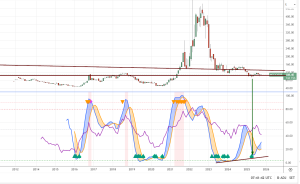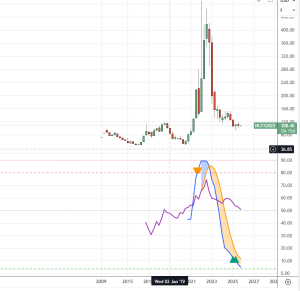
From Oversold to Grid‑Ready: Coal Plant Upgrades, Positive Divergence, and How the Next Leg Starts
Oct 31, 2025
The quarterly and monthly pictures say the same thing in different accents: oversold, flattening, coiling. Newcastle Coal sits in an extreme zone on both timeframes, while several coal equities behave as if they’ve already read the next chapter. That divergence is not decoration; it’s a habit in commodity cycles. Producers feel tightness first, then the benchmark admits it. If you want a clean frame: patience over excitement, pending orders over hot takes. A monthly close in the 132–136 band turns the key; from there, 160–165 opens, 180 is an overshoot, and the later path points to 216–225—with turbulence between floors.
Positive divergence on the monthly (momentum troughs rising while price retests) is your first receipt. Layer it with a simple set of triggers: On‑Balance Volume rising on down weeks; coal miner breadth thrust—at least 70% of your coal and power basket closing above the 20‑day average with expanding volume; and a capitulation day in the benchmark of −7–10% on two to three times average volume while equities hold flat or green. Two triggers mean prepare—three mean act. No triggers, no theatrics.
Quarterly chart
Monthly Chart
Microstructure Postcards: Tightness Hides in the Plumbing
Coal is bulky, political, and moved by ships that don’t read your timeline. Watch the curve: front‑month Newcastle flattening into the back hints at near‑term scarcity; outright backwardation shouts it. Track API2 (Atlantic) and API4 (South Africa) against freight (Baltic Dry). If spreads widen while freight climbs, the system is straining. China and India import prints, port stockpiles, and utility inventories add texture—slow data, but proper direction. These are not trivia; they are the small hinges that swing big doors when sentiment is asleep.
Trillion‑dollar pressers for data centres are mostly theatre until steel hits ground and electrons hit racks. Even if you believe in the “bigger models forever” hymn, there’s a wall: power. Demand is compounding faster than new generation connections. The smarter path for models—lean, specialised, mode‑switching intelligence—will squeeze more work from every watt, but the net draw still rises. The grid needs dispatchable muscle now. That’s where coal plant upgrades stop being impolite and start being obvious.
Coal Plant Upgrades: The Fastest, Messiest, Most Practical Fix
Coal plant upgrades fall into three categories. First: same‑fuel modernisation. Swap in higher‑pressure, higher‑temperature boilers and turbines, fit digital controls, and you can lift output by 10–20% within 6–18 months. In the 1990s–2000s, US utilities routinely added 50–150 MW this way. The constraint isn’t physics; it’s paperwork and crews.
Second: coal–gas hybridisation. Co‑firing 10–40% natural gas into existing coal boilers brings cleaner burn and faster ramp without ripping the heart out of the plant. It can take months to a year for modular systems to be standardised. Complete conversion goes further—strip the coal boiler, keep the steam turbine, add gas turbines and a heat‑recovery steam generator; you’ve built a combined‑cycle rhythm inside a coal shell. Typical timelines are 1–2 years, not 4–10. Shawville (Pennsylvania) completed a coal‑to‑gas conversion across ~590 MW in roughly 18 months. Joliet (Illinois) repowered ~1,326 MW. These are not hypotheticals; they are receipts.
Third: you respect the efficiency ladder and pick your fights. Old coal runs ~32–36% efficient; ultra‑supercritical coal hits ~40–45%; coal–gas hybrids can live in the 38–43% band; combined‑cycle gas sits at ~55–63% (with the record a touch higher). You don’t need miracles; you need speed and dispatchable capacity in the corridors where demand now bites.
Coal plants already have the skeleton the grid needs: transmission lines, cooling systems, rights-of-way, and towns that live off their hum. Cut emissions, and permits come more easily. Retrofit them into hybrid stations and you get what the renewables dream of—steady baseload with a flexible ramp that works with wind and solar instead of whining against them. In a grid choking on data centres and demand spikes, upgraded coal isn’t nostalgia—it’s the wrench that actually fits the bolt. Perfection is the enemy of power. This is the fix that keeps the lights on.
From Oversold to Attack: The Map and the Mile Markers
Translate the technicals into orders, not opinions. Treat 132–136 on Newcastle as the pivot zone; 136 is conviction, the line where sentiment shifts from disbelief to intent. A monthly close above 136 doesn’t whisper—it shouts. That move clears the path toward 160–165, where positioning flips from defensive to aggressive. Expect an overshoot into 175–185 as late money chases confirmation and funds re-rate exposure before the inevitable retest.
If fundamentals align—tight seaborne supply, Asian demand pulse, and freight rates holding—then the 216–225 arc opens as the next structural leg. But this isn’t a marriage; it’s a campaign. Trim the tactical slices into strength, recycle cash on exhaustion, and keep the core until the thesis fractures. Watch for three kill signals: supply re-acceleration in Australia, a policy choke that actually holds, or freight inversion that guts netbacks.
Everything else is just noise.
Positioning: Core vs Campaign, and How You Keep Your Nerve
Split your book. Core is the part you refuse to meddle with because it expresses the grid reality: dispatchable power is underpriced in a world that wants low‑latency AI at any cost. Campaign is your flexible sleeve—adds on resets, trims on spikes. Pre‑place bids at 132–136 and again at 140–144 if the first band is confirmed; size them small enough that you can add without bargaining with your nerves. Use OBV and volume to confirm that sellers are thinning. And keep one line taped to your screen: buy the flush you asked for; if you flinch, size was wrong.
Baseline (stair‑step): the pattern bottoms, monthly close confirms, price walks toward 160–165, wobbles, overshoots 180, retests, then sets up the run to 216–225. Miners stay a half‑step ahead; breadth trends firm. Squeeze: paper sellers tire, the curve flips to backwardation, freight climbs with flows, equities break clean, and the benchmark gaps higher in a week. Choke: policy headlines freeze capex, a USD spike and freight shock slam netbacks, and the complex sinks together. In that last case, you buy only if your triggers line up; otherwise, you save your ammo.
Policy and Risk: The Ways This Can Still Hurt You
Policy hits harder than price. Regional bans, export quotas, or court injunctions can freeze flow overnight. Carbon policy is worse—it moves in jerks, not gradients, and every lurch rewrites margins. Currency cuts both ways: a strong USD taxes importers and drags benchmarks; a bend lower fuels price optics but not always profits. Freight isn’t background noise—it’s leverage in disguise. When the Baltic Dry Index spikes, your margin evaporates even as spot looks strong.
Then come the landmines: single-mine outages, strikes, floods, or local politics that turn one producer’s problem into a sector headline. The antidote is structure. Cap single-name exposure. Use baskets if you can’t track every heartbeat. Keep dry powder so you add on confirmation, not emotion. This game rewards the disciplined predator, not the hopeful holder.
AI Without Power Is Fantasy
The argument for coal plant upgrades isn’t a hymn to the past; it’s a confession about the present. Data centres are meatspace. Racks need electrons. Even with more innovative models that switch modes and waste less, the grid strain is real. The fastest way to add dispatchable watts is to modernise the assets already connected. Replace boilers, modernise turbines, co‑fire gas, repower to CCGT where it pencils. Save the decade‑long battles for new nuclear while you shore up the next two years. This isn’t romance. It’s triage.
The green choir will keep chanting. Fine. Hated assets pay when physics has the vote. We’ve seen this film in other pits. The pattern is always the same: a ritual funeral at the lows, then a stair‑step rise as sceptics keep shorting yesterday’s story. You don’t need to be a zealot. You need to be early, sized right, and bored enough to wait. Coal plant upgrades aren’t a slogan; they’re a set of work orders. Markets eventually price the work.
Conclusion: How the Next Leg Starts
From oversold to grid-ready is a short distance on the chart and a long one in the gut. The 132–136 close is your first tell that sentiment’s flipping from fear to function. Term-structure tightening, breadth surges, and real volume through resistance confirm it’s not noise. The macro leg follows when coal plants stop dying on spreadsheets and start humming again—hybrid co-firing, carbon-cut retrofits, and repowers done in under two years. These sites already have transmission, cooling, and muscle memory; they just need permission and capital. That’s how the next leg begins: not in a press release, not in a climate summit, but in a control room where a wrench turns, a turbine spins, and the chart stops hesitating.
















